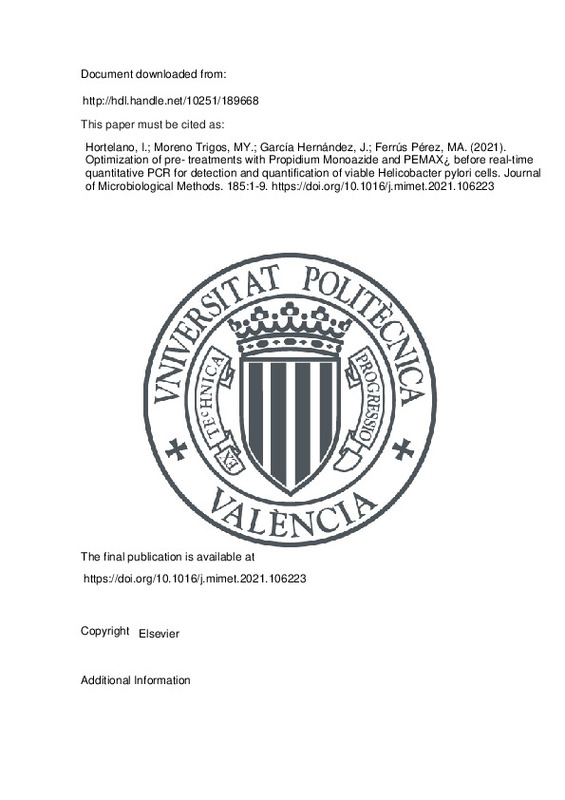JavaScript is disabled for your browser. Some features of this site may not work without it.
Buscar en RiuNet
Listar
Mi cuenta
Estadísticas
Ayuda RiuNet
Admin. UPV
Optimization of pre- treatments with Propidium Monoazide and PEMAX¿ before real-time quantitative PCR for detection and quantification of viable Helicobacter pylori cells
Mostrar el registro sencillo del ítem
Ficheros en el ítem
| dc.contributor.author | Hortelano, Irene
|
es_ES |
| dc.contributor.author | Moreno Trigos, Mª Yolanda
|
es_ES |
| dc.contributor.author | García Hernández, Jorge
|
es_ES |
| dc.contributor.author | Ferrús Pérez, Mª Antonia
|
es_ES |
| dc.date.accessioned | 2022-11-12T19:02:50Z | |
| dc.date.available | 2022-11-12T19:02:50Z | |
| dc.date.issued | 2021-06 | es_ES |
| dc.identifier.issn | 0167-7012 | es_ES |
| dc.identifier.uri | http://hdl.handle.net/10251/189668 | |
| dc.description.abstract | [EN] Accurate detection of H. pylori in different environmental and clinical samples is essential for public health studies. Now, a big effort is being made to design PCR methodologies that allow for the detection of viable and viable but non-culturable (VBNC) H. pylori cells, by achieving complete exclusion of dead cells amplification signals. The use of DNA intercalating dyes has been proposed. However, its efficacy is still not well determined. In this study, we aimed to test the suitability of PMA and PEMAXTM dyes used prior to qPCR for only detecting viable cells of H. pylori. Their efficiency was evaluated with cells submitted to different disinfection treatments and confirmed by the absence of growth on culture media and by LIVE/DEAD counts. Our results indicated that an incubation period of 5 min for both, PMA and PEMAXTM, did not affect viable cells. Our study also demonstrated that results obtained by using intercalating dyes may vary depending on the cell stress conditions. In all dead cell¿s samples, both PMA and PEMAXTM pre-qPCR treatments decreased the amplification signal (>103 Genomic Units (GU)), although none of them allowed for its disappearance confirming that intercalating dyes, although useful for screening purposes, cannot be considered as universal viability markers. To investigate the applicability of the method specifically to detect H. pylori cells in environmental samples, PMA-qPCR was performed on samples containing the different morphological and viability states that H. pylori can acquire in environment. The optimized PMA-qPCR methodology showed to be useful to detect mostly (but not only) viable forms, regardless the morphological state of the cell. | es_ES |
| dc.description.sponsorship | This work was supported by the Conselleria de Educacion, Investigacion, Cultura y Deporte, of the Community of Valencia, Spain, under project AICO/2018/273, and by the Spanish Ministerio de Ciencia e Innovacion PID2019-105691RB-I00 Grant and by the Spanish Ministry of Economy and Competitiveness AGL2014/53875-R Grant. | es_ES |
| dc.language | Inglés | es_ES |
| dc.publisher | Elsevier | es_ES |
| dc.relation.ispartof | Journal of Microbiological Methods | es_ES |
| dc.rights | Reconocimiento - No comercial - Sin obra derivada (by-nc-nd) | es_ES |
| dc.subject | Helicobacter pylori | es_ES |
| dc.subject | PMA-q PCR | es_ES |
| dc.subject | PEMAX(TM)-qPCR | es_ES |
| dc.subject | Viability | es_ES |
| dc.subject | Disinfection treatment | es_ES |
| dc.subject | Morphological states | es_ES |
| dc.subject.classification | MICROBIOLOGIA | es_ES |
| dc.title | Optimization of pre- treatments with Propidium Monoazide and PEMAX¿ before real-time quantitative PCR for detection and quantification of viable Helicobacter pylori cells | es_ES |
| dc.type | Artículo | es_ES |
| dc.identifier.doi | 10.1016/j.mimet.2021.106223 | es_ES |
| dc.relation.projectID | info:eu-repo/grantAgreement/AEI/Plan Estatal de Investigación Científica y Técnica y de Innovación 2017-2020/PID2019-105691RB-I00/ES/ANALISIS INTEGRADO DE LA DIVERSIDAD, CALIDAD Y SEGURIDAD MICROBIOLOGICA DE ALIMENTOS VEGETALES ECOLOGICOS MEDIANTE CULTIVO, TECNICAS MOLECULARES Y SECUENCIACION MASIVA/ | es_ES |
| dc.relation.projectID | info:eu-repo/grantAgreement/GVA//AICO%2F2018%2F273//DETERMINACION DEL RIESGO PARA LA SALUD PUBLICA DEBIDO A LA PRESENCIA DE H. PYLORI EN AGUA Y ALIMENTOS: DETECCION/ | es_ES |
| dc.relation.projectID | info:eu-repo/grantAgreement/MINECO//AGL2014-53875-R/ES/H. PYLORI Y OTROS HELICOBACTERS PATOGENOS EN AGUAS Y ALIMENTOS: DESARROLLO Y APLICACION DE HERRAMIENTAS MOLECULARES DIRIGIDAS A LA EVALUACION DEL RIESGO PARA EL CONSUMIDOR/ | es_ES |
| dc.rights.accessRights | Abierto | es_ES |
| dc.contributor.affiliation | Universitat Politècnica de València. Escuela Técnica Superior de Ingeniería Agronómica y del Medio Natural - Escola Tècnica Superior d'Enginyeria Agronòmica i del Medi Natural | es_ES |
| dc.contributor.affiliation | Universitat Politècnica de València. Instituto Universitario de Ingeniería del Agua y del Medio Ambiente - Institut Universitari d'Enginyeria de l'Aigua i Medi Ambient | es_ES |
| dc.description.bibliographicCitation | Hortelano, I.; Moreno Trigos, MY.; García Hernández, J.; Ferrús Pérez, MA. (2021). Optimization of pre- treatments with Propidium Monoazide and PEMAX¿ before real-time quantitative PCR for detection and quantification of viable Helicobacter pylori cells. Journal of Microbiological Methods. 185:1-9. https://doi.org/10.1016/j.mimet.2021.106223 | es_ES |
| dc.description.accrualMethod | S | es_ES |
| dc.relation.publisherversion | https://doi.org/10.1016/j.mimet.2021.106223 | es_ES |
| dc.description.upvformatpinicio | 1 | es_ES |
| dc.description.upvformatpfin | 9 | es_ES |
| dc.type.version | info:eu-repo/semantics/publishedVersion | es_ES |
| dc.description.volume | 185 | es_ES |
| dc.identifier.pmid | 33872638 | es_ES |
| dc.relation.pasarela | S\435214 | es_ES |
| dc.contributor.funder | Generalitat Valenciana | es_ES |
| dc.contributor.funder | Agencia Estatal de Investigación | es_ES |
| dc.contributor.funder | Ministerio de Economía y Competitividad | es_ES |







![[Cerrado]](/themes/UPV/images/candado.png)

